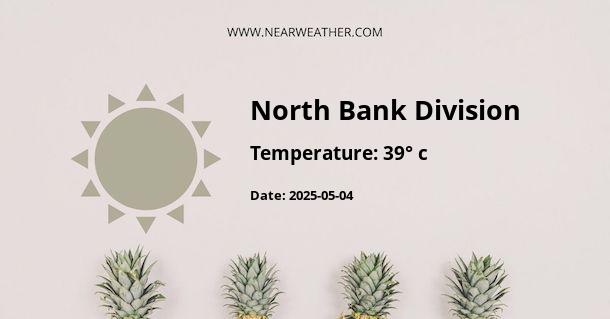Climate and Weather in North Bank Division, Gambia
North Bank Division is a region located in the northern part of the Gambia, a country situated in West Africa. The division experiences a tropical savanna climate characterized by distinct wet and dry seasons throughout the year. Understanding the climate and weather patterns in North Bank Division is crucial for residents and visitors alike, as it allows for better planning and preparation for outdoor activities and agricultural practices.
Temperature
The temperature in North Bank Division remains relatively high throughout the year, with little variation between seasons. The region experiences an average annual temperature of around 27°C (81°F), making it a warm and humid destination. The highest temperatures are typically recorded during the dry season, which occurs between November and May, with average highs ranging from 30°C to 35°C (86°F to 95°F). The coolest months are usually between December and February when nighttime temperatures can drop to around 15°C (59°F), providing some relief from the heat.
Rainfall
The rainfall pattern in North Bank Division is characterized by a distinct wet and dry season. The wet season typically starts in June and lasts until October, with the heaviest rainfall occurring in July and August. During this period, the region receives an average annual rainfall of around 1,200 to 1,500 millimeters (47 to 59 inches). The dry season, on the other hand, extends from November to May, with little to no rainfall. This prolonged dry period can lead to water scarcity and impact agricultural activities.
Humidity
North Bank Division experiences high humidity levels throughout the year due to its proximity to the Atlantic Ocean and the surrounding rivers. The average relative humidity hovers around 70% to 80%, creating a humid and sometimes uncomfortable environment. The humidity is most pronounced during the wet season when moisture levels are higher. It is advisable for visitors to pack lightweight and breathable clothing to stay comfortable in the region's high humidity.
Wind
The prevailing wind direction in North Bank Division is from the northeast, known as the Harmattan wind. This wind blows from the Sahara Desert and brings dry and dusty conditions to the region. The Harmattan wind is most prominent during the dry season, reducing visibility and causing a haze in the air. It is important to take precautions such as wearing protective eyewear and using moisturizers to minimize the effects of the dry wind on the skin and eyes.
Climate Hazards
While North Bank Division generally experiences a favorable climate, there are some climate hazards that can impact the region. These include occasional droughts, flash floods during heavy rainfall, and the risk of tropical storms and hurricanes during the Atlantic hurricane season, which runs from June to November. It is crucial for residents and visitors to stay informed about weather forecasts and follow any warnings or advisories issued by local authorities.
Agricultural Impacts
The climate and weather patterns in North Bank Division have a significant impact on agricultural practices in the region. The wet season provides favorable conditions for crop cultivation and supports the growth of various crops, including rice, millet, maize, and groundnuts. Farmers rely on the rainfall during this period to irrigate their fields and ensure successful harvests. The dry season, however, poses challenges as water resources become scarce, leading to reduced agricultural activities and reliance on irrigation systems.
Tourism and Outdoor Activities
The climate in North Bank Division offers favorable conditions for outdoor activities and tourism. The warm temperatures and abundant sunshine throughout the year make it an ideal destination for beach lovers and nature enthusiasts. The region is home to several national parks and reserves, including the Baboon Island National Park, where visitors can experience the diverse wildlife and natural beauty of the Gambia. It is advisable to plan outdoor activities during the dry season to avoid the potential disruptions caused by heavy rainfall.
Conclusion
The climate and weather in North Bank Division, Gambia, are characterized by a tropical savanna climate with distinct wet and dry seasons. The region experiences high temperatures and humidity throughout the year, with the dry season being the hottest. The wet season brings heavy rainfall, while the dry season is characterized by the Harmattan wind from the Sahara Desert. Understanding these climate patterns is essential for residents, farmers, and tourists to plan and adapt accordingly.
A - North Bank Division's Latitude is 13.500000 & Longitude is -16.000000.
A - Weather in North Bank Division is 27° today.
A - Climate Conditions in North Bank Division shows scattered clouds today.
A - Humidity in North Bank Division is 80% today.
A - Wind speed in North Bank Division is 12.35 km/h, flowing at 283° wind direction. today.
